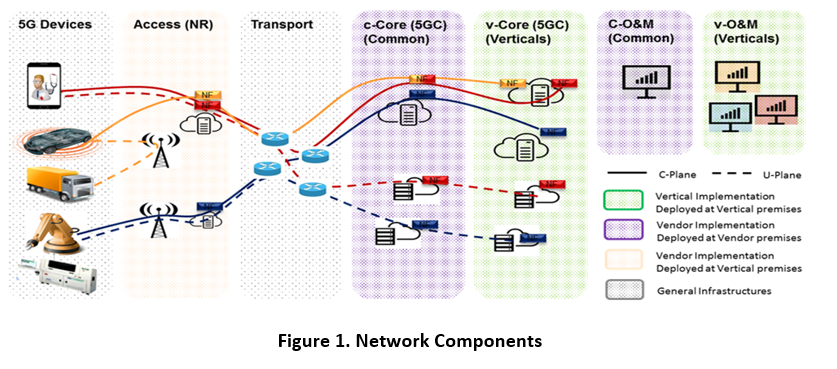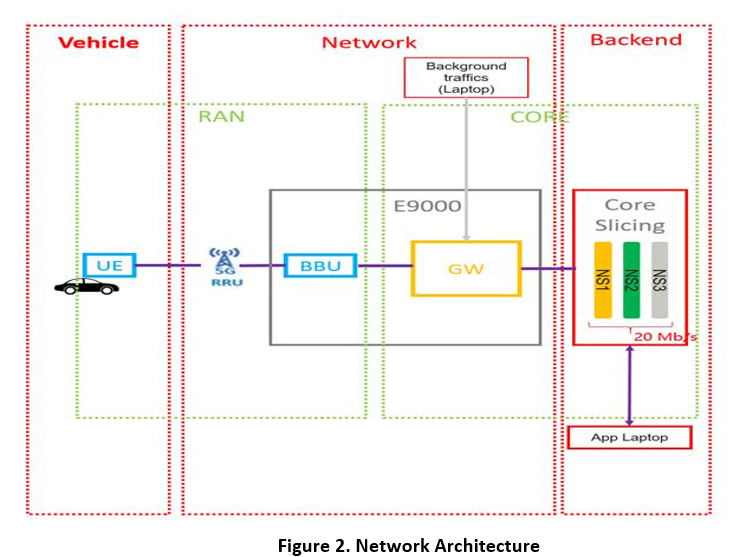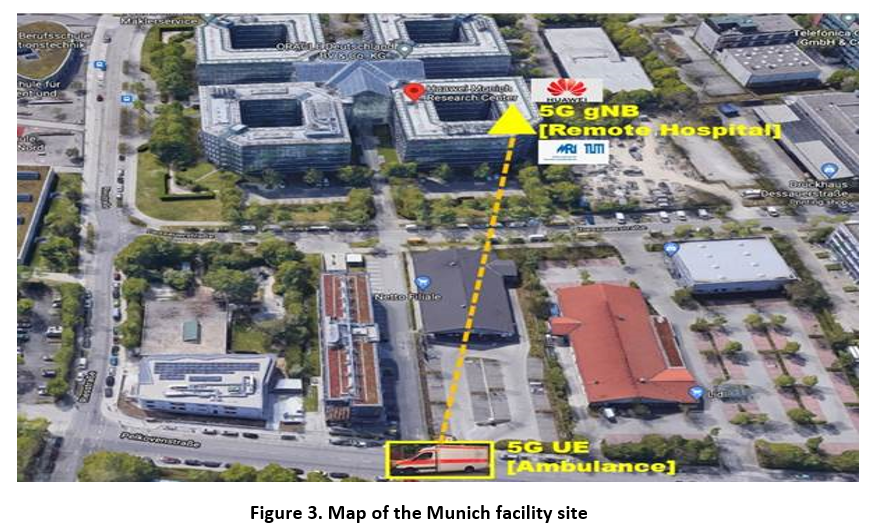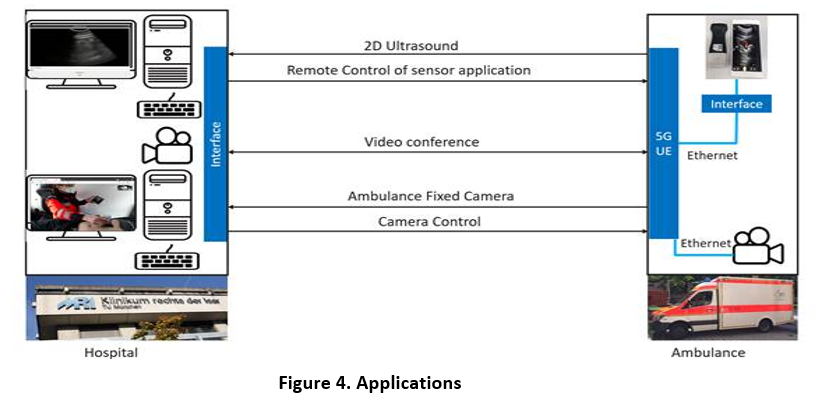Contact: germany-munich-facility@5g-vinni.eu
The Munich site for 5G tests and validation is located at Huawei Munich Research Center (MRC) in the north-west of Munich. A 5G base station is mounted at the rooftop of HUAWEI MRC at a height of 25 meters, equipped with one sector antenna covering an angular range of 120°. On terminal side, a 5G UE modem is mounted in an emergency car that can move in the coverage around the site, enabling to perform outdoor eHealth drive tests.
The 5G site is connected by an Ethernet link supporting high data rates to the core network, it is collocated with the base station. The core network provides SDN and NFV capabilities. The core network is further connected to a cloud data center, which is set up at the same location.
The base station site in Munich center is further equipped with a distributed data center for mobile edge computing, which allows to dynamically relocate the network functions of the core network to this distributed data center to facilitate short latency in the network for selected services, if required. The possibility of relocating network functions closer to the edge also allows the realization of a functional split, where the user plane functions are carried out locally at the site of the base station, while functions of the control plane are carried out in the core network at the distant location (Huawei MRC).
Summary of capabilities
- 5G RAN (Huawei) 3.41 GHz
- 5G Core (Huawei)
- MANO and NFVI (Huawei)
- SDN (Floodlight)
- Network slicing
- eHealth
- MEC
The focus of the KPI’s will be low latency and high reliability.
The use case that will be the focus of investigation at the 5G-VINNI experimentation site in Munich is the “Mobile Ultrasound”:
In the Munich Facility site, we perform the eHealth use case “Remote interventional support for emergency care application – mobile ultrasound”. The objective is to provide a 5G based data transfer, facilitating a bi-directional data transmission for ultrasound and video source, between a moving point of care, the ambulance car which is the first responder, and the university hospital where a medical expert is located (virtual presence).
The ambulance car is considered as first room of hospital, especially in rural areas where the next hospital may be far away. Application of technologically advanced diagnostic tools, e.g. mobile ultrasound, directly at the emergency site in the ambulance car prior to arrival at the hospital not only enhances emergency treatment options, but also increases patient safety in general and mentally pacifies staff. Especially as there is a lack of trained emergency doctors, and paramedics or young doctors who are inexperienced, alone, or stressed have to take primary medical care at the emergency site.
The test has been conducted in the Munich Facility site, Germany. It is a joint test between HUAWEI Munich Research Center (MRC) and Klinikum rechts der Isar, Technical University Munich (TUM/MRI). It is a part of the 5GVINNI project.
The facility comprises the following components, see Figure 1:
- 5G Radio Access Network (RAN) at one site, having
- Base station with one sector
- Carrier frequency: 3.41 GHz
- Bandwidth: 40 MHz
- Transmission power: 5 W
- Antennas: up to 8
- 5G UE modem
- Base station with one sector
- 5G Core network
- HW/SW platform, where a prototype substrate, on top of which a 5G Core Network will be implemented and tested. The available HW/SW infrastructure includes:
- Hardware: in-house platform comprising of several dozen powerful servers representing a data center.
- Software: software networks related testbed, comprising extended network emulators (e.g., cluster Mininet with Docker extensions), controllers (e.g., Floodlight), open-source and proprietary switch implementations. Besides, Huawei has implemented an orchestrating platform for scenarios relevant to virtualization. Among other things, the testbed can deploy virtual networks with different topologies as needed. Virtual networks can be deployed across a server cluster. Nodes in our testbed are not simple switches, instead, they are compute containers (e.g. Docker) that run distributed agent programs to test/evaluate various proposed protocols. This is illustrated in the right part of the snapshot which depicts the console of a node in the network on the left.
- 5G Core network supporting functional split – SDN – NFV Orchestration
- Distributed data centers for mobile edge computing use cases
- Transport network
- HW/SW platform, where a prototype substrate, on top of which a 5G Core Network will be implemented and tested. The available HW/SW infrastructure includes:
The experiment makes use of the 5G 3.41 GHz prototype system deployed in HUAWEI MRC facility. HUAWEI MRC provides pre-standard RAN and Core Network, the 5G UE prototype modem is mounted in the ambulance, and the base station and CORE network are located in HUAWEI MRC premises, see Figure 2.
The remote hospital operator is located indoors, while the Emergency car is placed outside the building, the base station (gNB) antenna is situated on the top roof of HUAWEI MRC and can provide a connection for the 5G UE mounted in the Emergency car, see Figure 3.
The medical equipment and applications are provided by TUM/MRI, the ultrasound unit (Clarius C3 HD (2-6 MHz), Clarius Mobile Health Corp., Vancouver, Canada) and the camera (PTZ-camera, Hikvision DS-2DE2A404IW-DE3/W, Hangzhou, China) are connected to the UE in the ambulance, and the remote hospital PC is connected to the CORE.
We address the RAN and Core Network (Slicing) aspects.
The demonstration is a 2 part setup, the emergency car side and the hospital side. Both sides are connected through 5G-VINNI Network using experimental 5G UE Modem and gNB, see Figure 4.
Our target in the test is to provide a 5G based data transfer facilitating bi-directional data transmission for ultrasound and video source between:
- The ambulance, equipped with a HUAWEI 5G experimental UE, high resolution camera and ultrasound system
- The hospital (remote medical expert), equipped with display monitor, camera and PC.
The scenario consist of the transmission of 2 different applications in parallel with low latency through the 5G network, the ultrasound unit and the video streaming from camera.






